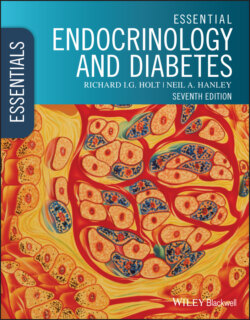Читать книгу Essential Endocrinology and Diabetes - Richard I. G. Holt - Страница 58
Box 3.1 Some basic facts about hormone receptors
ОглавлениеTissue distribution of receptor dictates the scope of hormone action:The thyroid‐stimulating hormone (TSH) receptor is expressed almost exclusively in the thyroid, therefore TSH action is largely restricted to the thyroidThyroid hormone receptor expression is widespread and therefore thyroid hormone action is diverse
Binding of hormone induces conformational changes in the receptor to initiate downstream signalling
Downstream signalling can differ across different cell‐types to produce diverse hormone‐mediated effects
Control is exerted in part through the ongoing synthesis, degradation and localization of hormone receptors – most target cells have 2000–100,000 receptors for a particular hormone
Cell surface hormone receptors
Bind water‐soluble hormones (e.g. peptides):
Transduce signal through membrane (that is otherwise impermeable to water‐soluble hormones)
Activate intracellular signalling pathways
Fast responses (seconds) possible
Nuclear hormone receptors
Bind lipid‐soluble hormones (e.g. steroid and thyroid hormones) which can pass through cell membranesFunction as transcription factors in the nucleusActivate or repress gene expression
Relatively slow responses (hours)
Figure 3.2 Basic components of a membrane‐spanning cell‐surface receptor. The hormone acts as ligand. The ligand‐binding pocket in the extracellular domain tends to be comparatively rich in cysteine residues that form internal disulphide bonds as part of a precise three‐dimensional folded structure. For some hormones, e.g. growth hormone, the extracellular domain can be cleaved and circulate as a potential binding protein. Circulating fragments of the thyroid‐stimulating hormone receptor can be immunogenic leading to auto‐antibody formation in autoimmune thyroid disease. The α‐helical membrane‐spanning domain is rich in hydrophobic and uncharged amino acids. The C‐terminal cytoplasmic domain either contains, or links to, catalytic sites, which initiate intracellular signalling stimulated by hormone binding.
